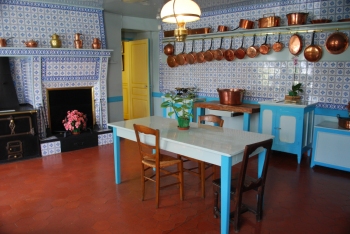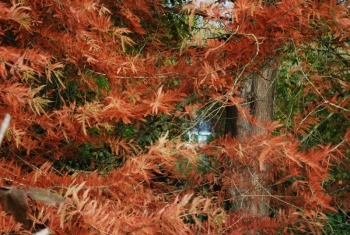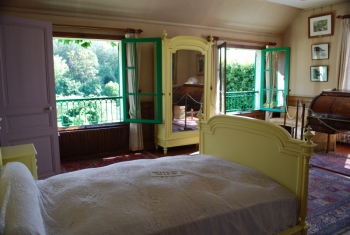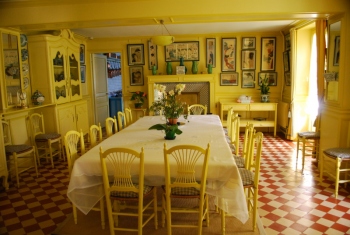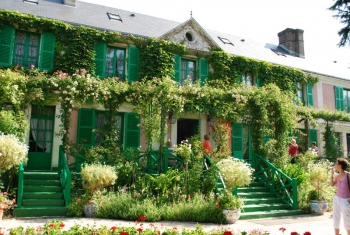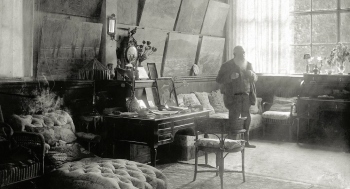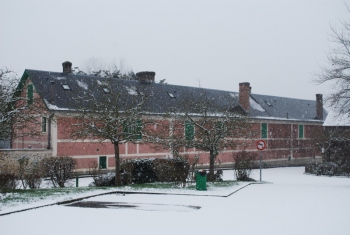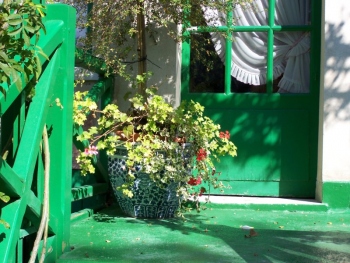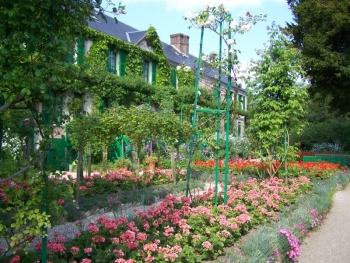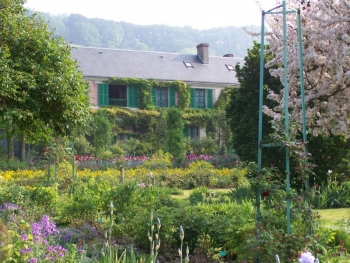Entries Categorized as 'Monet’s House'
November 10, 2009
Monet’s kitchen at Giverny has a delicious flavor of old fashioned kitchens, where the scent of jam seems to be still floating in the air.
Monet, as a gourmet, was very interested by all what was going on in the kitchen, but in his times it was a place for women only. He had a very good cook and collected recipes for her to test.
The kitchen Monet designed for his house is very well organised. Spacey, it is covered with blue Norman tiles. It could look cold, but all this blue is enhanced by the shiny coppers. An amazing collection of saucepans, pots and kettles of every shapes, to prepare delicious meals for a large bourgeois family and distinguished guests.
Posted in Monet's House 4 Comments »
October 26, 2009
Monet’s gardens at Giverny will soon close: next Sunday in the evening, on November 1st. Just before their Winter sleep, they offer a gorgeous show on the side of the water garden.
The tall trees that surround the pond change their green or dark red colors for much brighter ones.
The taxodium becomes as red as a squirrel. It will last a few days and then it will loose its needles, until new ones grow next Spring, giving it a fresh green look.
Through the branches of the taxodium, like a spying eye, one can spot a window of Monet’s house in the distance.
Posted in Monet's House, Water-Garden No Comments »
September 19, 2009
A detail strikes the visitors who enter Monet’s bedroom at Giverny: the bed is ridiculously small.
Claude Monet wasn’t very tall, and he didn’t share his bed with his wife. They had separate bedrooms. Not because they didn’t care, but rich families copied the aristocracy and had separate ‘appartements’, though they were connected.
Monet could get up very early without waking his wife. He loved to paint before sunrise, when the river is still covered with mist.
The bed and the armoire, which were not very expensive furniture, were painted according to Monet’s taste.
Monet had gorgeous views over his garden from his bedroom’s three windows. The painter designed his bedroom, he had it built just over the first studio. He wanted a lot of light in it.
The bedroom was the place where he hung his collection of impressionist paintings by his friends, an incredible collection of 35 canvases including 12 paintings by Cézanne, many Renoirs, Sysleys, Morisots, Manets and so on.
The desk is a beautiful antique from the 18th century.
Posted in Claude Monet, Monet's House 7 Comments »
August 2, 2009
I have just been given the right to take pictures inside of Monet’s House. I am thrilled being able to comment on this very special home I love!
Taking photographs in the museum is forbidden for several reasons, especially because of the very fragile japanese woodblocks that hang on the walls. Monet didn’t want his own work to decorate his home: it was work! He preferred something more exotic and fun. He would hang them everywhere except in his studio, in the kitchen and in his bedroom.
I don’t know what strikes visitors most when they enter the most beautiful room of the house, the famous dining room. The Japanese prints cover the walls, almost masking them, their mainly blue color matching the yellow furniture, walls and moldings.
It is strangely modern, especially when compared with the very heavy and dark fashion in matter of decoration in Victorian times. Bright, and stunning. Everybody says waow! when stepping inside of this yellow dining room, and most people like it. But for some visitors, it is too yellow.
Posted in Monet's House 11 Comments »
June 26, 2009
I had to wait until there were a few people at the entrance to Monet’s house in Giverny before I could take this picture. Generally I take great care there isn’t anybody on the snapshot. It was fun doing exactly the contrary, for a change.
I wanted to please Virginia, who paints lovely pictures of Giverny. While she was in Monet’s gardens, Virginia photographied his house, but once back at home she realised she missed the scale for characters.
Actually, the picture looks more lively with people on it. Why must we always wait and take empty pictures? To give the illusion we were alone on the site? Or just to avoid photographying people we have not been introduced to?
Monet’s house is not that easy to paint, because of the perspective. To see it you must stand on its side, for two yews hide the house when you face it. It was Monet’s idea to mask the building, as it is extremely long: about 40 meters, 130 feet! Strangely enough the house is very narrow, only 5 meters.
Posted in Monet's House 1 Comment »
January 28, 2009
This is a view of Claude Monet standing in his first studio amidst his favorite canvases. The light of the afternoon is almost palpable.
This room located in his main house at Giverny was turned into his sitting-room after 1890.
When Monet became successful, he built a new house in the corner of his garden, where he moved his studio. He had now a well lit large room to work in and to store his paintings. The former studio became a place where he used to have a liquor after lunch, where he would sit to read a gardening book or a novel by Maupassant. Monet also used to write many letters.
The paintings for sale where displayed in the second studio whereas he kept the ones he cherished too much to sell them in the first studio.
The picture was made in springtime according to the tulips behind Monet. The photo reveals how much the painter loved flowers. There were at least six vases in his studio on this day!
Posted in Claude Monet, Monet's House 4 Comments »
January 17, 2009
Monet’s house at Giverny looks exceptionally long while it is shallow.
The reason for this disproportion? Monet bought a medium sized farm, but he needed more space because of his extended family. Therefore he added two wings to the original building.
On the right he converted a former barn into his first studio. Over the studio he had his own bedroom and bathroom. Monet had even his own stairs and a garden door at his disposal in order not to disturb the family life when he went out early to paint, or when he came in with art collectors.
On the other side of the house, Monet demolished the tiny farm kitchen and designed a big and modern one, more suitable for a bourgeois family with gourmet tastes.
Over this new kitchen there were rooms for Alice’s four daughters. The four boys had their rooms in the attic.
Posted in Monet's House No Comments »
June 8, 2008
Monet’s home in Giverny has three entrances, each one dedicated to a particular use.
This is typical for the time when the house was built, in the 19th century.
One door was devoted to Monet’s own use. It leads directly to his first studio and to the stairs to his bedroom. It enabled Monet to go in and out without disturbing the family life – he liked to get up exceedingly early in the morning – or perhaps without being disturbed by the family life – there were eight children in the family. This entrance could be called the professional one.
There was of course a main entrance for family members and guests.
The third one was a domestic entrance leading directly to the kitchen.
Posted in Monet's House No Comments »
May 21, 2008
Monet was 42 when he arrived in Giverny.
Let’s say he was in his forty-third year, and he spent forty three years in Giverny. Exactly half of his life!
When he arrived he was looking for a big house to live with his family. He was lucky enough to find this one.
He felt so happy there he never wanted to move anymore.
Posted in Monet's House No Comments »
April 23, 2008
Monet’s home is painted into pink, a pale pink that matches the Japanese cherry trees and the crab apple trees blooming in April, at the beginning of the season.
In the spring freshness, pink seems to be everywhere, from the tulips aligned in front of the house in island beds to the many pansies scattered in the mixed borders.
All these pinks are enhanced by the tender green of the new born leaves and grass.
Posted in Monet's House Comments Off on The Pink House
